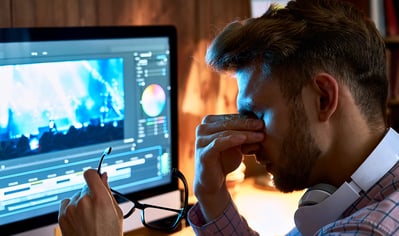Have you ever noticed temporary blurry vision, eye fatigue, or even headaches after attending a virtual event, webinar, or especially after a long day of remote work?
If so, you may be experiencing visual fatigue.
With many of us working remotely since the pandemic, it's understandable that screens have become increasingly present in our lives, catering to our daily needs for several years now.
Imagine our webinar and webcasting experts at PQM.net who spend their entire day in front of a screen!
But do all these hours spent in front of screens have an impact on our health?
Let's take a step back and take a closer look at this phenomenon to see if there is any truth to the rumours.
In this article, we will examine the effects on your health of spending long hours in front of a screen all day long, and what can happen if you don't take specific measures.
Let's start by defining two terms.
What is visual fatigue?
Visual fatigue is a condition that causes eye strain and discomfort after prolonged use of a computer screen, tablet, or smartphone.
Symptoms include headaches, dry eyes, eye pain, and blurred vision.
What is blue light?
It is a wavelength found in the visible part of the white light spectrum.
It has been known to impact sleep by suppressing the production of melatonin, a hormone that regulates our sleep cycle.
Computer screens, smartphones, and tablets all emit blue light, so spending too much time in front of these devices can disrupt our sleep and make us tired during the day.
Symptoms of eye fatigue, how to prevent it?

"In the presence of artificial blue light, we tend to squint, which creates visual tension. We have a feeling of dry eyes, which can cause headaches. Visual performance is also affected. Blue light is diffuse and creates glare, making it difficult to see details and contrasts." Source: Alexandre Sasseville, excerpt from La Presse
Here are five (5) measures you can take to prevent or reduce symptoms of screen-related eye fatigue.
1) Take regular breaks
Make sure to take frequent breaks when working on your laptop or other light-emitting digital devices.
The general rule is 20-20-20.
The rule consists of regularly diverting your gaze from your screen every 20 minutes, focusing on something else that is about 20 feet (6 meters) away for at least 20 seconds.
This will help reduce eye fatigue and give your brain a well-deserved rest.
Overuse of screens can lead to "computer vision syndrome" or CVS.
This temporary condition is characterized by eye fatigue and irritation, red eyes, the infamous headache, and blurred vision.
It is usually caused by a prolonged fixation on the computer screen.
In general, the symptoms subside after a break away from the screen.
2) Use of glasses
Opt for purchasing a pair of glasses dedicated to blocking blue light, also known as "computer glasses," which filter a portion of the "harmful" spectrum emitted by screens for human eyes.
These glasses will not completely eliminate visual fatigue or solve the problem entirely, but they can help alleviate symptoms.
3) Contact lenses
If you wear contact lenses, give your eyes a break by wearing glasses in front of a screen. This will help reduce the risk of dryness and irritation.
Have artificial tears on hand that you can use at any time if you cannot remove your contact lenses or do not wish to wear them.
4) Lighting issues
Adjust the lighting in your room to avoid working in a completely dark environment or under intense fluorescent lights.
Ideally, it is best to have a balance between natural and artificial light, but especially daylight from the sun, which is by far the best source of light.
Consider investing in an LED bulb.
These alternatives are particularly recommended for those who wish to purchase a bulb with low blue light emission.
LED bulbs generally have a longer lifespan compared to other types of bulbs, while consuming less energy, making them a more environmentally friendly option: a win-win situation!
5) Screen position for your eyes
Ensure that your screens are positioned at eye level and at a distance of about arm's length.
Having a screen positioned too low, regardless of the device, can cause tension in the neck and lead to eye fatigue.
Unable to adjust your screen? No problem, use a laptop stand, which you can purchase online or at any good electronics store.
For a quick and cost-effective solution, you can simply place a book under your laptop to elevate it.
6) And most importantly: Disconnect!
It would be wise to try to incorporate good sleep habits by disconnecting from your digital screens at least 60 minutes before bedtime.
This will help you have a peaceful night's sleep and wake up feeling refreshed the next day.
Blue light can disrupt and interfere with sleep cycles.
"[...] it has been shown to suppress the production of melatonin, a hormone that helps regulate our sleep-wake cycles. This can lead to problems getting enough sleep and can have other adverse effects on health." Source: Canadian Association of Optometrists
A very interesting study conducted by Harvard Medical School has demonstrated the effects on sleep as well as a possible correlation with diabetes. Study here.
So, no more Instagram and TikTok of cats and babies before bedtime!
In conclusion
The precise cause of this condition remains unknown and no specific treatment is available, but it is undeniable that visual fatigue and its effects are real phenomena that can lead to various symptoms such as fatigue, headaches, and blurred vision.
If you have been experiencing increased fatigue recently, it could be attributed to an increase in your screen time and very possibly to overexposure to blue light.
By applying these few simple yet significant steps, you will instantly feel better.
Go ahead! It's now time to do a "20-20-20."


